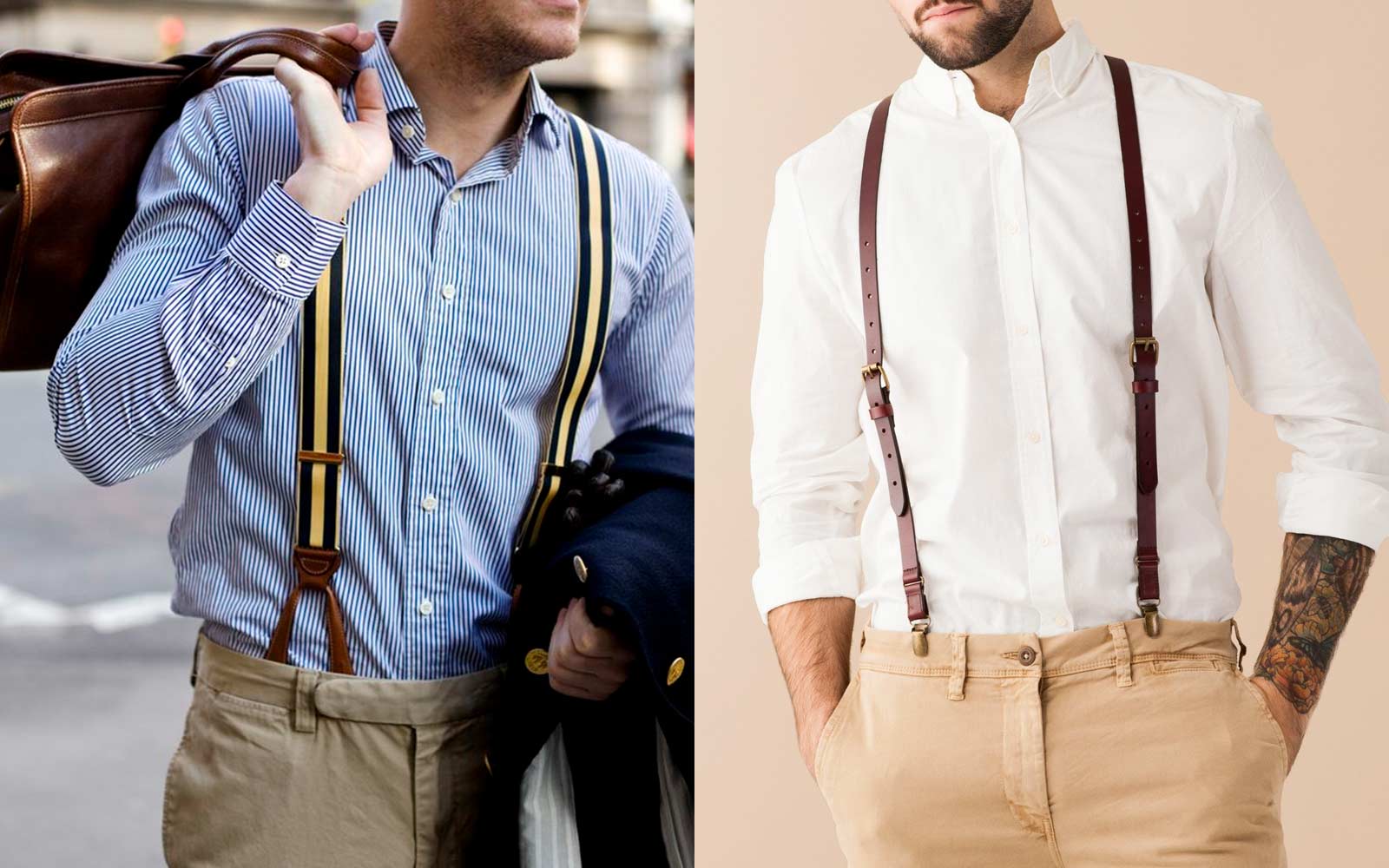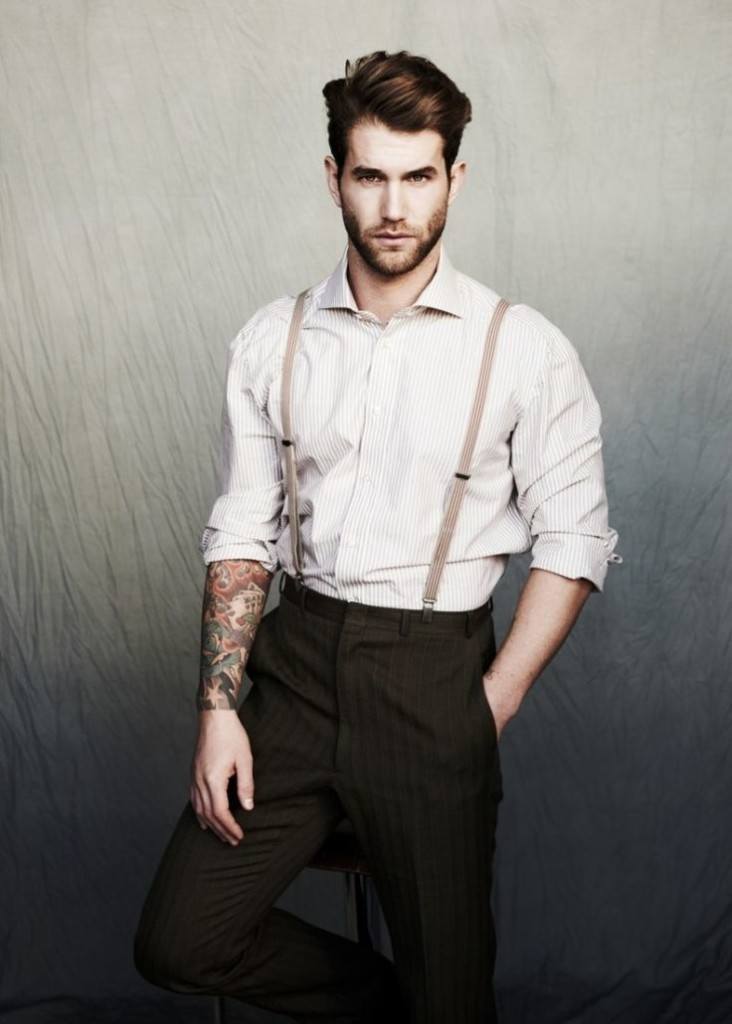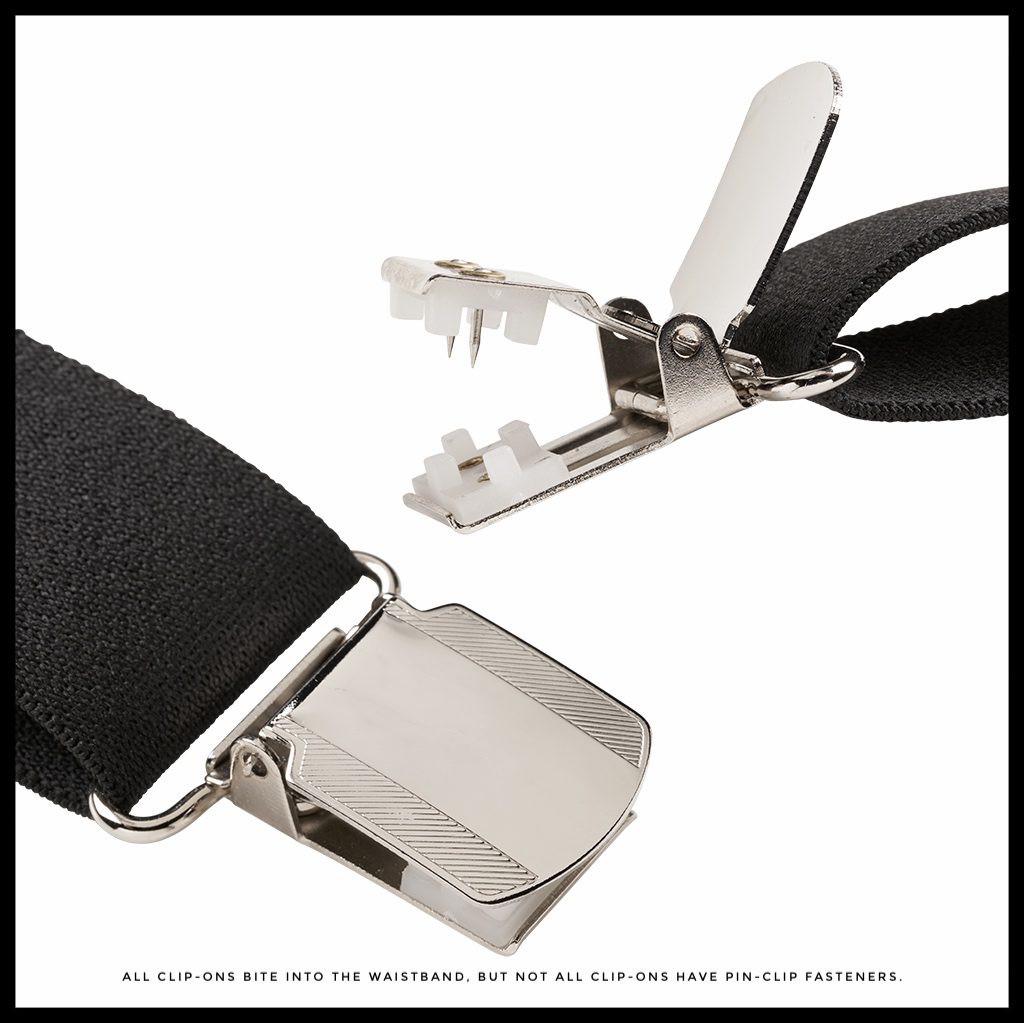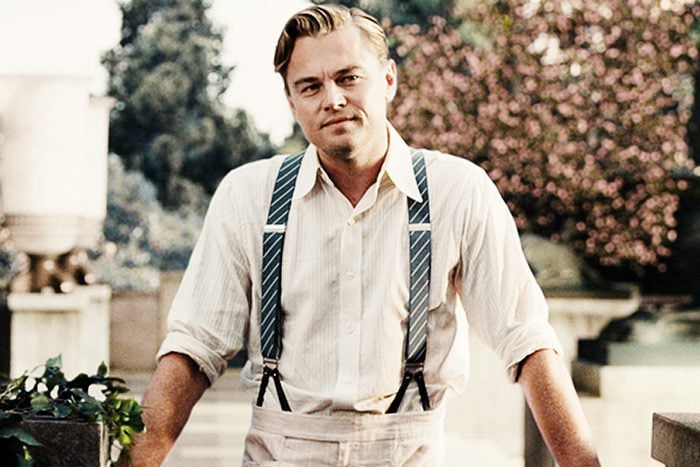Clip-On vs. Button-Hole Suspenders
Is it okay to wear clip-on
suspenders?





Written by Ellis Perry
Are clip-on suspenders hopelessly
tacky? If a man is going to wear suspenders, should he stick exclusively to
suspenders with button-hole tabs? These are good questions, and they deserve
good answers.

There is a case to be made for
clip-on suspenders, and that case is much stronger than the best case that
could ever be made for the clip-on necktie or clip-on bow tie. There are a few
good reasons why some men should sometimes wear clip-on suspenders, and why all
men should feel comfortable experimenting with them. The GentleManual sureys the landscape in
“Everything You Need to Know About Suspenders,” but what’s still needed is a
clear statement as to why men shouldn’t default thoughtlessly to clip-ons.

PIN-TERESTING: “Pin-clips” are
alligator clasp fasteners with one or more pins inside the clasp. The pins
ensure that the clips stay snug and secure on your waistband. They work well,
but they puncture the material onto which they are fastened. All gator-clasps
squeeze little teeth into the waistband, and over time this can compromise the
integrity of the material. Pin-clips gnaw at the fabric immediately. Image:
suspenderstore
Clip-Ons Aren’t Traditional…
Or Are They?
Clip-on suspenders have been
around since 1894, and the argument “One shouldn’t wear clip-on suspenders
because they’re not traditional” is difficult to sustain. With over a century’s
worth of history, they’re as classic as any “classic” could be. Scroll through
collections of old photos and you’ll see clip-on suspenders in abundance, from
the Millennials of 1900 to the ruffians of original punk rock. Heritage isn’t
the issue. The real problem with clip-ons these days is two-fold.
First, many of the big stores
that sell everything from fertilizer to frozen french fries sell clip-on
suspenders in their menswear departments. Marketplace ubiquity, affordability,
and ease of use are the main virtues of mass-produced clip-on suspenders, most
of which are made of semi-elasticated material. It is precisely this
wide-distribution of low price clip-ons which gives rise to concerns about
their street-cred.
When belts (and buckles)
returned to the forefront of fashion, clip-on suspenders continued to appeal
chiefly to three sorts of men: those who were accustomed to suspenders but
never got on board with button-fastened ones; those who didn’t give a damn
about actively presenting “a look;” and those whose style-sense tended to be at
odds with trending notions of what counted as fashionable. Today the situation
is a little dire. To put it bluntly, too many men wear clip-on suspenders with
get-ups that make fashion police wish they were packing more than disapproving
grimaces.
Clip-on Suspenders are
old-school. That’s not the problem.
And that’s the second issue:
all clip-on suspenders suffer a bit from guilt-by-association. It’s unfair,
perhaps, but that’s just how it is, and a man wearing clip-on suspenders risks
finding himself in the same situation as the man who wears a clip-on bow tie:
if you’re going to wear a bow tie (argues the purist), you should take the time
and make the effort to learn how to tie one; and if you’re going to wear
suspenders, accept the extra expense and hassle involved with adding buttons to
the inside of the waistband of your trousers and wear button-tab suspenders.
This is one school of thought.
Appliance vs Accessory
But how strong, really, is the
analogy between the clip-on tie and clip-on suspenders? To settle the issue, we
need to take note of an important distinction, the distinction between an appliance
and an accessory.
Don’t think of an appliance as
a prosthetic, or as the category-name for things like ovens and toasters.
Understand the word ‘appliance’ as meaning applied-to-use, and as pointing
directly to a specific function. When suspenders (or belts, or anything) are
worn solely or chiefly for function, and utility is the paramount
consideration, then they are appliances and not accessories. Like belts,
suspenders are trouser-securing tools.
Some men – depending on their
build, and perhaps also their occupation – may find suspenders more
comfortable, more convenient, or more flattering than a belt. If your line of
work has you in a tool belt or utility belt, or if a belt buckle tends to
interfere with your ability to get comfortably close to a bench, workstation,
countertop, or piece of machinery, then suspenders may be the way to go. And if
function is your overarching consideration, then there’s nothing wrong and a
lot right with clip-ons.
Utility? Go for it. Style?
Tread lightly.
On the other hand, if you
intend to wear suspenders with a bespoke or fitted-suit (in which case you’d
not even need a belt), or specifically as part of a style-astute ensemble and
you don’t really need them to hold-up your trousers, then your suspenders are not
an appliance but an accessory. Here, the analogy with the bow tie is very apt:
if you can’t choose the right bow tie and tie it properly, perhaps it’s best
not to wear one; and if you are now and then trading your belt for a pair of
suspenders, rise fully to the occasion and take them seriously. If you’re
donning braces with a passion for fashion and an eye to being someone’s
eye-candy, clip-ons can make or break your intended look.
Why The Buttons Really Matter

Leonardo DiCaprio as Gatsby,
showing why button-hole suspenders are a notch above clip-ons. Note the absence
of belt loops on the trousers. This explains the necessity of the suspenders,
and shows how button-hole braces present a sleeker, tidier look.
Suspenders fastened with
buttons (or studs) can bring their own problems, but here’s their primary
virtue: they communicate that you have
made a very deliberate decision to wear suspenders. Anyone can whip off his
belt, snap-on a pair of alligator clasp suspenders, and fancy himself an
insouciant dandy. And let’s be snobby for a moment: button-hole braces are not
typically available in like likes of Target, and button-hole braces often cost
much more than the “fast fashion” clip-ons found in H&M. This is no
criticism or indictment of Target, H&M, or fast fashion. But whatever
clip-ons may or may not imply, button-hole suspenders do say three things about
a man:
He aims to source, own, and
wear unique, quality merchandise — he puts effort into getting the gear.
- He puts thought into arranging his ensemble — he puts effort into getting the look.
- He cares equally about big details and subtle details, and pays attention to their interplay — he puts effort into getting it all right.
Button-tab suspenders evince
attention to detail
Let us say it again: as an
appliance, there’s nothing wrong with clip-on suspenders. Contemplated as
accessories, though, clip-ons are the easy way out, and they scream I couldn’t
be bothered with the buttons. And that’s problem — because bothering is the
heart and soul of style. Button-tabs say: you did bother with the buttons, and
you did so because you do appreciate details and do make an effort to look your
best. Clip-ons dodge the extra steps. That’s the rub.
Button-fastened braces will,
on the whole, be pricier, but the range of product available to you is much
more extensive. This is the second reason to have buttons sewn into the
waistband of your trews: if you intend to wear suspenders regularly, set
yourself up to enjoy a much wider range of quality options. Not to labor the
point, but here too the comparison with bow ties is apposite: there’s a world
full of interesting, well-made self-tie bow ties, and there are gorgeous
top-shelf button-tab suspenders out there.
You have more high-end options
when you have buttons.
So: are clip-on suspenders a
sartorial abomination, or just cheap and cheerful? The answer is: both. If you
are wearing a pricey suit, or have invested in alterations in order to give a
good suit a bespoke fit, then take that extra step and have buttons added to
the waistband. Clip-ons will drag down your ensemble and undermine the value of
the tailoring. If function is not your main concern and you are just
experimenting with different casual looks and ensembles, clip-ons are not necessarily
tacky, provided that you take them as seriously as you would any other
accessory.
When Clip-on Suspenders Are
Okay
- You are wearing suspenders solely for reasons of comfort or convenience.
- You are wearing suspenders because they are best suited to your occupation or to whatever it is you will be doing in them.
- When you are wearing a dinner jacket and cummerbund, the cummerbund hides the tabs/yokes of the suspenders (the part that connects to the waistband of your trousers). Since none can see whether the fasteners are clip-ons or buttons, clip-on suspenders with a tux will work in a pinch.
- You are making an effort to look like a dork, and the suspenders are part of your dorky ensemble.
- You are going for a period look — and that’s any period after 1894 — and you are indifferent as to whether or not people appreciate that clip-ons are more than a century old.
- You are wearing suspenders to hold-up fishing waders, field-trousers, or something similar. If you’re wearing belted trousers, and you’re going to wear some kind of sporting or protective trousers over them, then clip-ons are fine. Many of these sorts of trousers anticipate this and are made with buttons or studs for suspenders; but easily-sourced and inexpensive heavy-duty industrial-type clip-on suspenders can turn any oversized jeans (etc.) into protective workwear. Having a pair on hand isn’t a bad idea.
- You are experimenting with suspenders generally before taking the plunge and having buttons sewn into your waistbands.
Ellis Perry
SOURCE: THE GENTLEMANUAL
SOURCE: THE GENTLEMANUAL
Comments
Post a Comment